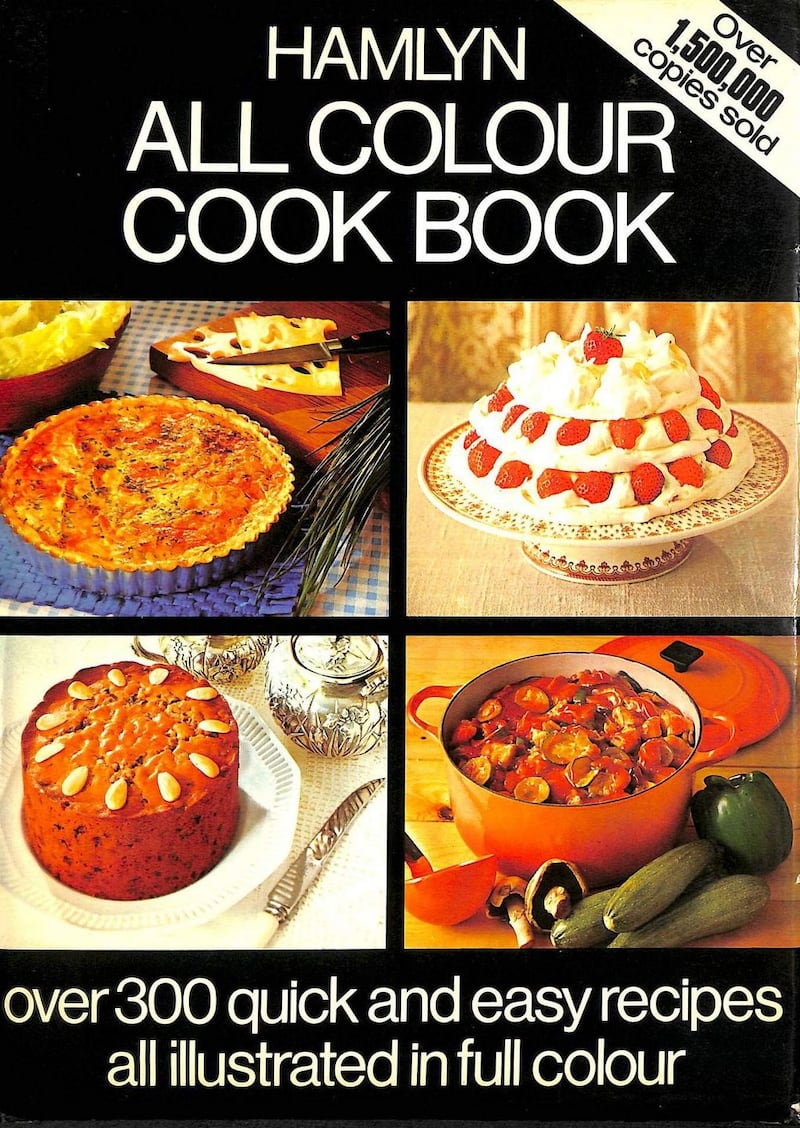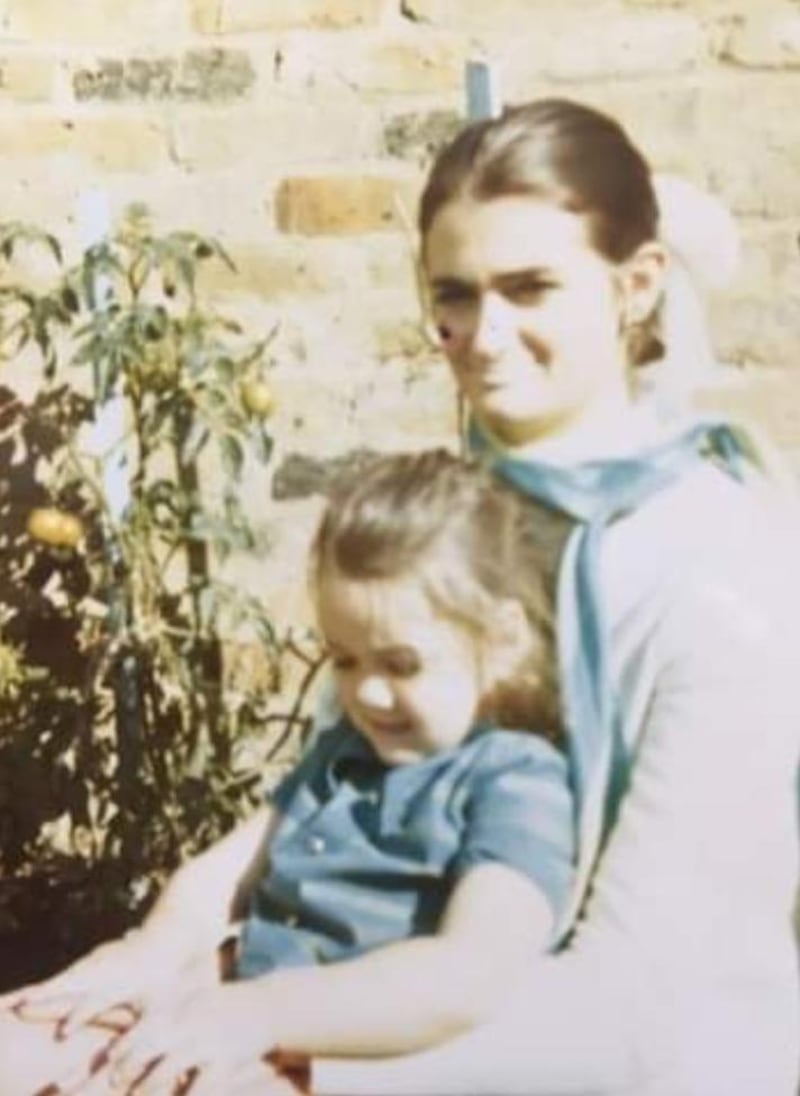I own 96 cookbooks. Most of them are on a teak bookcase in my kitchen, but there are some in the shed, the bedroom, the living room, the utility room and the roof space. I also have four box files stuffed with recipes ripped from newspapers and magazines, and several butter-smeared notebooks of hand-written notes and menus. For my whole childhood my mother cooked from one book: the Hamlyn All Colour Cook Book.
Published in 1970 and written by Mary Berry and two women I’ve never heard of since, (a similar fate befell the two women who worked with Julia Child on Mastering the Art of French Cookery) it boasts “over 300 quick and easy recipes all illustrated in full colour”. Full colour is an understatement.
The food is unnaturally lurid and laid on scarlet tablecloths. The distinction between savoury and sweet has collapsed. Glacé cherries, peaches and bananas are paired with pork products. Most disturbing of all is the turkey in aspic, a hunk of cold poultry and mandarin orange segments suspended in a piss-coloured jelly set as firm as perspex. Everything is round or swirly; pineapple rings, fish mousse shaped like a life buoy, concentric circles of tiny cream rosettes. The effect is trippy, mesmerising.


Some of the recipes scarcely qualify as cooking; chicken mayonnaise is just that. Tins of concentrated oxtail, mushroom or tomato soup are used as sauces. Luncheon meat and diamonds of pimentos from a jar are put on crackers and called canapés. But there are some gems in there too. The apple scone my mother made every year at Halloween. The rice pudding sprinkled with demerara sugar that came out of the oven smelling as sweet as baby milk, with a skin like tortoise shell you had to crack with a spoon.
And recipe 316 in the Cooking with Cream section. In the photograph, chicken simla is packed into an orange casserole dish, coated in a thick, pale sauce and garnished with toasted flaked almonds, skinned tomatoes and watercress. The greenery is springy and there is no steam, so it must have been photographed cold.
Buzz of those nights
My mother’s version of it had a thin, beige sauce that pooled on the plate, glistening with chicken fat, the double cream slightly split. It wasn’t an everyday meal. She cooked it on the rare occasions she had people round for dinner, when she got out the Tyrone crystal hock glasses and red candles. My sisters and I were fed and ordered upstairs before the guests arrived, and I used to sit on the top step, hoping to overhear something juicy I wasn’t meant to hear.
When my mother brought the food to the table she always said “chicken simla, or something similar” and everyone laughed. The smell of it sent me into paroxysms of envy, and fury at the injustice of our banishment.

In the morning, my sisters and I would sweep the kitchen for leftovers. A swallow of Canada Dry from the bottom of a can, or pink, maggoty prawns from a teacup in the fridge. We pulled flitters of chicken from a cold thigh or drumstick, our noses wrinkling at the piquant smack of Coleman’s French mustard and Worcestershire sauce. It was better than nothing, but I always thought we had been excluded from the best part; sitting around the table. I spent nearly 30 years working in restaurant kitchens trying to recreate the buzz of those nights. The fizz of butter in a pan, the clatter of cutlery, the sound of laughter softened by wine.
The book seems hideously kitsch now, but there was something heart-breakingly earnest and aspirational on those pages. There were tips on how to cut corners and save time and money, on how to substitute ingredients that were scarce or unavailable. In the absence of aubergines, for example, my mother made a decent if robust moussaka with sliced potatoes.
I haven’t bought a cookbook for years. Most of the ones I own favour style over substance, and rarely have more than two or three recipes you would bother to cook again. My mother cooked her way through everything life threw at her, from Christmases and birthday parties to the Ulster Worker’s Council strike, from a single book. For the very many women like her who worked in the home, busting themselves to make things lovely for the rest of us, the Hamlyn All Colour Cook Book was all they needed.
CHICKEN SIMLA
Ingredients
4 chicken joints (I prefer to cut a whole chicken in eight pieces)
1oz (25g) seasoned flour
2 tablespoons oil
2oz (50g) butter
1/2 pint (280ml) chicken stock (made from a cube dissolved in boiling water)
2 tablespoons mustard (Coleman's French, ideally)
2 tablespoons Worcestershire sauce
1/4 pint (140ml) double cream
Method
1 Toss chicken in seasoned flour and fry until golden in butter and oil.
2 Arrange in a shallow, ovenproof dish then pour over the hot stock mixed with the mustard and Worcestershire Sauce. Cover and bake for 1 hour at 160 C.
3 Stir in cream and sprinkle with flaked almonds.
4 Garnish with fresh tomatoes and watercress – serve.
Unless you’re a fan of slimy chicken skin and watery sauces, I would leave the dish uncovered. My mother served hers over patna rice, a variety you rarely see now that came in a dusty plastic pouch. Basmati would do nicely, although Uncle Ben’s long grain is probably the most 70s option. And I’d serve the watercress and tomato on the side as a salad, rather than as a garnish.



















